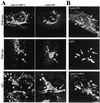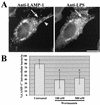Disruption of the Salmonella-containing vacuole leads to increased replication of Salmonella enterica serovar typhimurium in the cytosol of epithelial cells
- PMID: 12011022
- PMCID: PMC127987
- DOI: 10.1128/IAI.70.6.3264-3270.2002
Disruption of the Salmonella-containing vacuole leads to increased replication of Salmonella enterica serovar typhimurium in the cytosol of epithelial cells
Abstract
Salmonella enterica serovar Typhimurium is a facultative intracellular pathogen that inhabits a vacuolar compartment, called the Salmonella-containing vacuole (SCV), in infected host cells. Maintenance of the SCV is accomplished by SifA, and mutants of this Salmonella pathogenicity island 2 type III effector replicate more efficiently in epithelial cells. Here we demonstrate that enhanced replication of sifA mutants occurs in the cytosol of these cells. Increased replication of wild-type bacteria was also observed in cells treated with wortmannin or expressing Rab5 Q79L or Rab7 N125I, all of which caused a loss of SCV integrity. Our findings demonstrate the requirement of the host cell endosomal system for maintenance of the SCV and that loss of this compartment allows increased replication of serovar Typhimurium in the cytosol of epithelial cells.
Figures




References
-
- Baldeon, M. E., B. P. Ceresa, and J. E. Casanova. 2001. Expression of constitutively active Rab5 uncouples maturation of the Salmonella-containing vacuole from intracellular replication. Cell. Microbiol. 3:473-486. - PubMed
-
- Brumell, J., P. Tang, S. Mills, and B. Finlay. 2001. Characterization of Salmonella-induced filaments (Sifs) reveals a delayed interaction between Salmonella-containing vacuoles and late endocytic compartments. Traffic 2:643-653. - PubMed
-
- Brumell, J. H., C. M. Rosenberger, G. T. Gotto, S. L. Marcus, and B. B. Finlay. 2001. SifA permits survival and replication of Salmonella typhimurium in murine macrophages. Cell. Microbiol. 3:75-84. - PubMed
Publication types
MeSH terms
Substances
LinkOut - more resources
Full Text Sources

